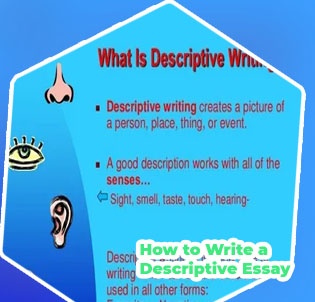- Home
- Order
- Price
- Samples

Descriptive paragraph writing examples

Are you struggling to write descriptive paragraphs that truly capture the essence of your subject? Look no further! Below are three articles that provide excellent examples and tips to help you improve your descriptive writing skills.
Mastering Descriptive Paragraphs: Techniques and Examples
"Mastering Descriptive Paragraphs: Techniques and Examples" is a comprehensive guide for writers looking to enhance their descriptive writing skills. The book provides a detailed overview of the key elements that make a descriptive paragraph effective, including vivid imagery, sensory details, and figurative language. Through a series of examples and exercises, readers are able to practice these techniques and improve their own descriptive writing.
One of the strengths of this book is its clear and concise explanations of each technique, making it easy for readers to understand and apply them to their own writing. The examples provided are diverse and engaging, allowing readers to see how descriptive paragraphs can be used in a variety of contexts. Additionally, the exercises at the end of each chapter help reinforce the concepts discussed and provide an opportunity for readers to practice what they have learned.
Overall, "Mastering Descriptive Paragraphs: Techniques and Examples" is a valuable resource for writers of all levels who are looking to improve their descriptive writing skills. Whether you are a beginner looking to learn the basics or an experienced writer looking to refine your craft, this book has something to offer. By mastering the techniques outlined in this book, writers can create vivid and compelling descriptive paragraphs that will captivate readers and bring their writing to life.
Crafting Vivid Descriptions: A Guide to Descriptive Writing
Crafting Vivid Descriptions: A Guide to Descriptive Writing is a valuable resource for writers looking to enhance their descriptive skills. This comprehensive guide offers practical tips and techniques for creating vivid and engaging descriptions that capture the reader's imagination.
One of the key strengths of this guide is its focus on sensory details. By incorporating sights, sounds, smells, tastes, and textures into their descriptions, writers can bring their settings and characters to life in a way that resonates with readers. The guide also emphasizes the importance of using precise language and avoiding cliches to create fresh and original descriptions.
In addition to providing practical advice, Crafting Vivid Descriptions also includes numerous examples and exercises to help writers practice their descriptive skills. By actively engaging with the material, writers can improve their ability to create evocative and immersive descriptions that draw readers into their stories.
Overall, Crafting Vivid Descriptions: A Guide to Descriptive Writing is a valuable resource for writers looking to enhance their descriptive writing skills. By focusing on sensory details, precise language, and originality, this guide can help writers create vivid and engaging descriptions that bring their stories to life.
This article is important for writers who want to improve their descriptive writing skills by providing practical tips and techniques for creating vivid and engaging descriptions.
Show, Don't Tell: How to Write Descriptive Paragraphs That Engage Readers
"Show, Don't Tell: How to Write Descriptive Paragraphs That Engage Readers" is a comprehensive guide for writers looking to improve their descriptive writing skills. The book provides practical tips and techniques for creating vivid and engaging descriptions that draw readers into the story.
One of the key takeaways from the book is the importance of using sensory details to bring scenes to life. By appealing to the five senses – sight, sound, touch, taste, and smell – writers can create a more immersive reading experience for their audience. The book also emphasizes the value of showing, rather than telling, in order to allow readers to draw their own conclusions and become more emotionally invested in the story.
In addition to offering advice on descriptive writing, the book also includes exercises and prompts to help writers practice their skills. By encouraging writers to actively engage with the material, the book helps them to internalize the principles of effective description and apply them to their own work.
Overall, "Show, Don't Tell: How to Write Descriptive Paragraphs That Engage Readers" is a valuable resource for writers looking to elevate their descriptive writing skills. Whether you're a beginner looking to improve your craft or an experienced writer seeking to refine your technique, this book offers practical advice and guidance to help you
- Personal reflection essay
- Essay hook examples
- Personal essay for scholarship
- Good introductions for argumentative essays
- Compare and contrast essay example
- Good ways to start an essay
- Descriptive essay about your favorite place
- Examples of thesis statements for argumentative essays
- Analytical essay
- Personal statement essay examples
- Narrative descriptive essay example
- Essay editor
- 1000 word essay
- Coursework writing service
- Leadership essay
- Website that pays you to write
- Best essay writing service
- Example of expository essay outline
- Write my philosophy essay
- Process analysis essay
- Write an argumentative essay
- Body of an essay
- Descriptive essay about technology
- Reflective essay introduction example
- Write my paper
- 500 word essay
- Help with writing a paper
- Essay writing websites
- Buy essay
- Chegg essay
- Essay about using mobile phone
- Personal essay
- Writing a history essay
- Rhetorical analysis essay
- Writing a essay
- Write research paper service
- Good hooks for research essays
- Essay about volunteer work
- Writing a scholarship essay
- Mit essays
- Descriptive essay example about a place
- Introduction for persuasive essay
- Critique essay
- Essays for sale
- Persuasive essay topics
- Free compare and contrast essay examples
- A essay example
- Interesting topics for persuasive essays
- Expository essay
- How to make an essay longer
- Essay writer
- Are apa papers double spaced
- Format of essay writing
- A persuasive essay
